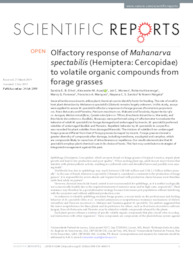Olfactory response of Mahanarva spectabilis (Hemiptera: Cercopidae) to volatile organic compounds from forage grasses.
Olfactory response of Mahanarva spectabilis (Hemiptera: Cercopidae) to volatile organic compounds from forage grasses.
Author(s): SILVA, S. E. B.; AUAD, A. M.; MORAES, J. C.; ALVARENGA, R.; FONSECA, M. G.; MARQUES, F. A.; SANTOS, N. C. S.; NAGATA, N.
Summary: Several herbivorous insects utilize plant chemical cues to identify hosts for feeding. The role of smell in host plant detection by Mahanarva spectabilis (Distant) remains largely unknown. In this study, assays were applied to assess M. spectabilis olfactory responses to forage grasses (Pennisetum purpureum cvs. Roxo Botucatu and Pioneiro; Panicum maximum cvs. Makueni and Tanzânia; Hyparrhenia rufa cv. Jaraguá; Melinis minutifora; Cynodon dactylon cv. Tifton; Brachiaria brizantha cv. Marandú; and Brachiaria decumbens cv. Basilisk). Bioassays were performed using a Y-olfactometer to evaluate the behavior of adult M. spectabilis to forage damaged and undamaged by insects. M. spectabilis preferred volatiles of undamaged Basilisk and Pioneiro. Repellent behavior by M. spectabilis to cospecifcs was recorded for plant volatiles from damaged Marandú. The mixture of volatiles from undamaged forage grasses difered from that of forage grasses damaged by insects. Forage grasses showed a greater diversity of compounds after damage, including menthone, eucalyptol and camphor, which are compounds likely to cause loss of attractiveness or repellence. Our results demonstrate that M. spectabilis employs plant chemical cues in its choice of hosts. This fact may contribute to strategies of integrated management against this pest.
Publication year: 2019
Types of publication: Journal article
Unit: Embrapa Dairy Cattle
Observation
Some of Embrapa's publications are published as ePub files. To read them, use or download one of the following free software options to your computer or mobile device. Android: Google Play Books; IOS: iBooks; Windows and Linux: Calibre.
Access other publications
Access the Agricultural Research Database (BDPA) to consult Embrapa's full library collection and records.
Visit Embrapa Bookstore to purchase books and other publications sold by Embrapa.

